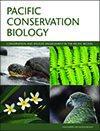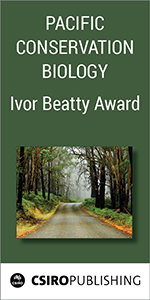How might human–macaque encounters be managed with technological assistance? In this article, we will outline a proposal for a technology-assisted approach to wildlife management in Singapore, describe how we applied our technological tools to the activity log cataloguing the macaque activity on a campus, and demonstrate how this approach might promote better and data-driven decision-making on the wildlife management front.

Volume 29 Number 1 2023
PC21045Taxonomic revision reveals potential impacts of Black Summer megafires on a cryptic species
 , Harry A. Moore, Mitchell A. Cowan
, Harry A. Moore, Mitchell A. Cowan  , Teigan Cremona, Judy A. Dunlop
, Teigan Cremona, Judy A. Dunlop  , Sarah M. Legge
, Sarah M. Legge  , Grant D. Linley, Vivianna Miritis, John C. Z. Woinarski and Dale G. Nimmo
, Grant D. Linley, Vivianna Miritis, John C. Z. Woinarski and Dale G. Nimmo
Sound taxonomy is the cornerstone of biodiversity conservation. How do we conserve a species if we are unaware of its existence? We present a case where the reclassification of a formerly widespread species – the sugar glider – has increased the threat posed by the catastrophic Black Summer megafires.
PC21045 Abstract | PC21045 Full Text | PC21045PDF (3.7 MB) | PC21045Supplementary Material (521 KB) Open Access Article
PC21041What predicts community members’ intentions to take action to protect koalas?
 , Dan Lunney
, Dan Lunney  , Jonathan Rhodes, Ross Goldingay, Scott Hetherington, Angie Brace, Lorraine Vass, Marama Hopkins, Linda Swankie, Nicole Garofano, William Goulding
, Jonathan Rhodes, Ross Goldingay, Scott Hetherington, Angie Brace, Lorraine Vass, Marama Hopkins, Linda Swankie, Nicole Garofano, William Goulding  and Clive McAlpine
and Clive McAlpine
Community members can play a key role in helping to protect threatened koala populations through engaging in community conservation groups, conservation initiatives, regeneration on their land and advocacy. The current paper identifies key factors that predict community members willingness to engage in these actions.
The relatively undegraded Lower Goodradigbee River is used to explore the role of alien fish and alien fish stockings in declines and extinctions of large-bodied native fish. Historical evidence and fish sampling data strongly support the hypothesis that these processes alone can cause large-bodied native fish declines and extinctions.
PC21048 Abstract | PC21048 Full Text | PC21048PDF (16.2 MB) | PC21048Supplementary Material (471 KB) Open Access Article
Wild deer are increasing in population size and geographic range across much of south-eastern Australia, yet some areas with emerging populations lack suitable species distribution information. Our research aimed to predict habitat suitability for wild deer in the South Coast region of New South Wales. We found that the majority of the region is suitable for wild deer, and our models can be used to improve monitoring and management across the region.
PC21033Whale sharks (Rhincodon typus) feed on baitfish with other predators at Ningaloo Reef
We provide rare in-water evidence of whale sharks feeding on baitballs in the presence of other predators. Our observations provide evidence of the complexity of whale shark feeding behaviour and provide a compelling insight into the interactions of this species with other predatory taxa in Western Australia.
PC21033 Abstract | PC21033 Full Text | PC21033PDF (581 KB) | PC21033Supplementary Material (76.1 MB) Open Access Article



